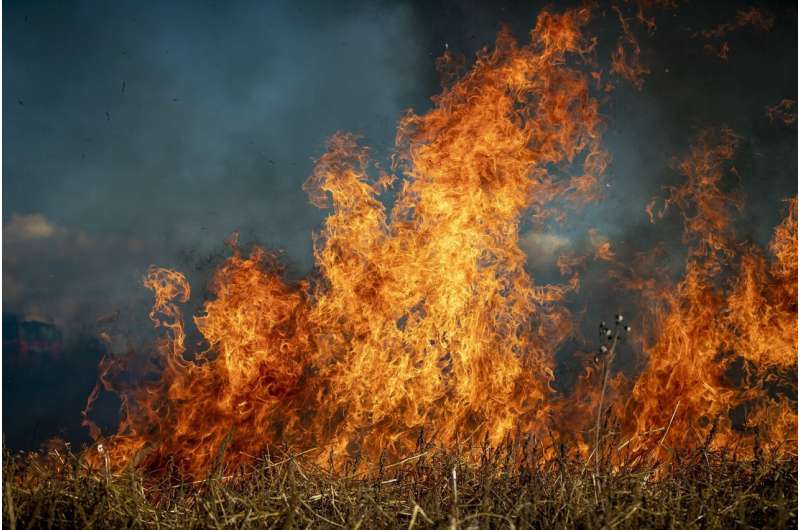South Africa's famous fynbos must be preserved鈥攂ut burning invasive plants on site isn't the best strategy

Invasive plants and trees were introduced to South Africa from as early as the 17th century for a range of commercial, subsistence and ornamental uses. Today, every area of the country has been invaded by a variety of these plants. The most species are found in the Western Cape, Eastern Cape and KwaZulu-Natal provinces, and major urban centers.
Invasive plants such as port jackson, black wattle and gum trees threaten the country's water security by using up too much water. They also fuel fires by adding biomass into the ecosystem, particularly those ecosystems where trees would not naturally grow. Invasive plants (including trees) can also degrade pasture lands by converting them into woodlands, full of plants that grazing animals do not eat.
As a consequence, concerted efforts have been made in projects run by to clear these plants and replace them with indigenous vegetation. Clearing invasive plants can be done through various methods such as herbicide spraying or chopping them down.
In South Africa's Western Cape, a common feature of clearing efforts is the "stack burning" method. This is where invasive plants such as port jackson are chopped down, stacked on top of each other and allowed to dry out before being burnt.
Clearing efforts are focused on the Western Cape's fynbos ecosystem. The fynbos is the country's most invaded ecosystem and most of the research on invasive plants has taken place in this ecosystem. Despite the large extent of invasive plants in the fynbos, the ecosystem has , containing a high number of endemic species found nowhere else on Earth.
But stack burning has its downsides because it leaves burn scars on the land.
I'm a land restoration specialist and environmental scientist who how stack burning affected the ability of fynbos to regenerate naturally. I visited 80 stack burn scars in two different fynbos ecosystem types in the Western Cape. I revisited the burnt sites every year for three years after the invasive plants had been removed and their biomass burnt away.
that full recovery of stack burn scars remains limited up to three years after clearing. One of the key research findings was that fynbos had not grown back fully even three years after the burning took place. Furthermore, the two fynbos ecosystem types recover differently.
To reduce the effects of stack burning, wherever possible, other clearing methods should be used. This could include removing the biomass without burning or burning the biomass on existing roads within the site.
Tracking the impact
I studied two types of fynbos ecosystems in the Western Cape: mountain fynbos and lowland fynbos. These are some of the ecosystems with the highest density of invasive plants in the country.
I set up observation areas at the center and edge of each burn scar and outside it. These measured one square meter each. For three years after burning, I counted the number of species that were found each year in the center and at the edge of each burn scar.
I then compared the burnt area with plots outside the burn scar where no fire had occurred.
The heat of the fire at the center of the stack reaches over 300掳C. At the edge, temperatures reach 175掳C. This often leaves persistent stack burn scars on the land. Stack burn scars are areas that have been left charred and stripped of vegetation by the intense fires during stack burning.
Stack burning leaves scars on the earth
Stack burning has negative effects on the environment. These include:
- persistent scars that are an eyesore across the landscape
- limited native biodiversity recovery in burnt areas (as shown by my research) because the vegetation takes so long to grow back
- secondary invasion鈥攚here other invasive plants that were previously not present find space to germinate and grow
- changes to the the soil chemical, physical and conditions. For example, stack burning can wipe out microbes that are crucial for the success of native plants.
that areas at the center of the stack remain severely affected and do not fully recover even three years after the stack burn. Areas at the edge of the stack recover within two years.
This shows that cutting down invasive plants and burning them on site prevents those areas from recovering naturally on their own. They will need help from humans to regrow.
Another important finding was that the two fynbos ecosystem types recover differently. Lowland fynbos recovers faster than mountain fynbos. Restoration specialists need to develop restoration plans that are tailored to the specific ecosystem.
What needs to happen next
To reduce the effects of stack burning, wherever possible, other clearing methods should be used. For example, invasive plants can be cut down and removed. They do not need to be burnt on site. Alternatively, the biomass can be removed and burnt on mountain roads, where the fires won't damage natural fynbos.
Where stack burning is unavoidable, there may be a need to apply fynbos seeds to stack burn scars to improve native species recovery. Stack burn scars could also be covered with surrounding topsoil to encourage recovery of native soil seed banks and microbial communities. However, this is labor intensive, so it would probably only be feasible at small scales.
Provided by The Conversation
This article is republished from under a Creative Commons license. Read the .![]()



















